
Original Link: https://www.anandtech.com/show/2275
The Single 12V Rail SilverStone Olympia OP650
by Christoph Katzer on July 13, 2007 12:00 PM EST- Posted in
- Cases/Cooling/PSUs
Introduction
Not too long ago, a rogue division of Cooler Master left to form their own company called Silverstonetek. While they are arguably more famous for their HTPC cases today, Silverstone has already developed a vast number of power supplies and is getting stronger with each new series.
The Olympia series is designed by Silverstone's newly acquired crew that came over from several member of different teams of the power supply business. With this move, Silverstone makes it clear that they are interested in branching out into other areas of the power supply market. At the CeBIT earlier this year, they were already showing a server power supply, and more will follow in the near future.

There are two things which help this power supply stand out from most other units. Silverstone is one of the first manufacturers that is actually returning to Taiwan for production. What's noteworthy about this is the fact that Silverstone has set up a robot factory in Taiwan that is building the PSU totally by itself. The positive effect of this is the same as what we see with things like car manufacturing where the work is done by robots: the overall soldering and precision is just better than it is by hand. This fact can be seen quite clear later when we take a look inside of this unit.
The second special characteristic is the single 12V rail. In a time when other manufacturers are building up to six 12V rails in their PSUs, Silverstone has come up with a single rail able to pull a load up to 54 amps. If we look to the actual Intel ATX12V specs, it states that there should be no rail with more than 20 amps for safety reasons. That's a fine step but not possible when you listen to the graphics card manufacturers. They ask for up to 30 amps from a single 12V rail which would make every OCP kick in if reached since they lie at around 24 amps. The result would be a shut-down of the PC while running the actual application. With a single 12V rail Silverstone went in another direction. If you have enough power to supply every component in the PC from a single rail, there would never be any problem since the PSU is regulating all the power drawn from just one source.
This might be a valid way to design a power supply, but, even though we don't know what it is, Intel probably had a reason for designing the specifications around a 20 amp per 12V rail limit. Silverstone backs up their design choice by stating that there is no application which could force this kind of power supply to fail. We have not heard of any problems in the field with a single high current 12V rail, and in our tests we weren't able to provoke this power supply into failing. We will make sure to pay close attention to this during the tests.
Packaging and Appearance


The box comes in traditional dark colors. Inside you will find the PSU, a rubber connector, screws and cable-ties. The power supply itself is coated in a soft black matte like all power supplies from Silverstone. The 12cm fan is located in the middle of the upper side and is secured with a black fan-guard. This PSU is an all-rounder which means it can be connected to any AC output from 100 up to 240Vac. This is already standard for most manufacturers and for Silverstone it seems to be so much of a standard that they even didn't mention it anywhere on the package.



The back of the power supply, which is located inside of the PC when installed, is totally closed except for the small opening in the lower-left side. This is to provide a little extra ventilation to cool the coil sitting directly behind it.
The Fan
The fan-guard of the 12cm fan is embedded in the housing of the power supply which is good for cases that do not have enough space for the added bulge. The fan itself is the Everflow model R121225BU rated at 0.4 amps. Silverstone says on the package that it will only run up to 22 dB(A). The fan is connected with a two-pin connector to the fan control on the PCB which makes it easy to remove when opening the power supply.


Cables and Connectors
All cables extending out from the power supply are sleeved up to the first connector. After the first connector the cables are left without. Here Silverstone tries to save some cash since it is not easy (and therefore expensive) to sleeve the cables after the first connector. The yellow cables are marked with different colors as is done with PSUs having more than two 12v rails. Indeed we will see more evidence of this later: the PCB Silverstone used in this power supply was originally designed with four separated 12v rails.


The cables have a minimum length of about 20" and connectors are spaced at about 5". The OP650 has two 6-pin PEG connectors which enables it to run a decent SLI or Crossfire system. In addition there is an 8-pin PEG connectors which is necessary for PCIe v2.0 compliant graphics cards requiring more than 225W of power (like the AMD Radeon HD 2900 XT with overdrive enabled). The six SATA and four 4-pin drive connectors are definitely enough to run a high-end system.
The Inside
After opening the housing we are presented with a very clean and systematic arrangement of components. Firstly, the two big heatsinks reveal the first signs of the old Etasis crew. In the most recent designs from Etasis, we find power supplies built with two printed circuit boards that still fit into a standard sized housing. This was made possible through the selection of components which are very short.

The same is clearly visible on first sight in our Silverstone Olympia power supply. Where other manufacturers are using a big capacitor on the primary section, Silverstone designed their PSU using three smaller ones to fit under the massive heatsink. The second difference to most other power supplies is that there are three transformers in the middle of the PCB. Normally this is implemented with one big transformer used to generate all outputs to the PC and a smaller transformer to generate the 5v stand-by rail.
Filtering stage

The filtering stage is taken really seriously in the OP650. We found an EMI-filter which is basically there to prevent interferences from the power supply going back into the AC source. The three yellow blocks between the ferrite coils are called X-capacitors and the Y-caps are positioned on the far right side under the heatsinks. Beside this is the rectifier bridge which converts the alternating current into direct current. Silverstone placed it direct on the primary heatsink in order to help dissipate the heat generated by the rectifier.

Primary Side

The primary side includes the PFC stage. It is mostly constructed with its own printed circuit board containing the PFC silicon (active PFC). Some power supplies have microchips with a combined PFC and PWM control which is important for the secondary stage. This power supply, however, is built with a single active PFC chip on the extra PCB.
Like we mentioned earlier, there are three small main caps on the primary side instead of only one big one. They are separately rated with 150µF and built by Hitachi. This company is used by many other manufacturers as well. The last shot shows the rectifier bridge on the far right side directly connected to the heatsink.


The Transformers

As mentioned before, Silverstone is using two main transformers in this power supply. We have seen this in several other power supplies from Tagan and Cooler Master. But just because a two transformer design is used by more than one manufacturer doesn't mean they're all created equal. There are several ways in which transformers can output different rails. You can, for example, let the one transformer generate several 12v rails and the second one does the 5v and another 12v rail. Or let one transformer generate only one 12v rails and everything else on the second one. The 3.3v rail is, in every case we've seen, generated with a voltage divider from the 5v rail. This is also done with the negative 12v rail from one of the positive 12v rails. Silverstone is running the two transformers in tandem to provide all rails simultaneously.
Secondary Side

The secondary side has its own printed circuit board just as the primary side does. The board contains the protection features (including OCP, OPP, SCP, and UVP) and the fan control. The fan control is connected to two temperature sensing diodes which have been attached to the secondary heatsink (the hotter heatsink while running). They are attached on the right and left side and interact with each other to control the speed of the fan. The upper connector on the PCB is the output to the fan on the upper side of the power supply. The output is controlled through a potentiometer.
On the lower right edge of the PCB we found a small switch. This switch is actually to turn off the OCP on each of the four 12v rails to "combine" them into a single one. This is a very common method as most other manufacturers approach rail separation the exact same way. Normally separated 12v rails can be generated with just these separated OCPs on each rail. They have one or two 12v rails and just split them into a few more in order to show a higher number of 12v rails.



All the capacitors on the secondary side are from Taepo. The company is quite popular and used by many other manufacturers as well. The cables are nicely connected to the PCB and all of the cables have shrinking hoses in the end, how it should to be for certain security matters. The coils have a very good winding quality like all the others in this PSU as well. It would have been nice if Silverstone had started the sleeves of the cables inside of the PSU. This raises the overall quality and importantly for most users it looks better.


Testing
We have already described our test setup and methodology here. Due to increasing heat the lower voltage rails will most likely decrease in output. This results from the tremendous ambient temperature in which we are testing power supplies and does not necessarily reflect what you will have in your PC at home. This is essentially a worst case test with respect to heat, and if the PSU performs well in our environment, you can be assured it will perform well in your PC. We are testing with 115VAC and 230VAC to cover all markets. To make the voltage drop more visible we will include graphs instead of tables. Above and below the dashed lines are out of spec values. Everything within these lines is within the specs and therefore acceptable.
To properly load the power supply we are using a Chroma DC Load. In this way we are able to put a specific amount of load on each of the connected rails. We are testing in ten steps beginning with 10% load and ending with 100% of each power supply's maximum output. The total procedure is taking us 5 hours for each of the two input voltages.
115VAC 3.3V, 5V, and 5Vsb Tests
The lower voltage rails have dropped hard during the test and they went under specification at about 80-90% of load. The 5v rail dropped under spec at around 65% load. With 230VAC things looked a little better. This could have been partly because we tested 230V first and the power supply might have been sweating it.
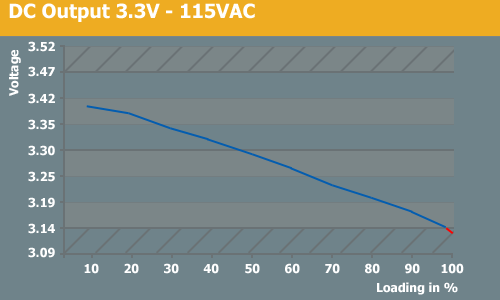
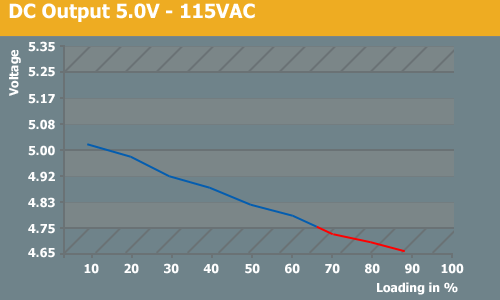
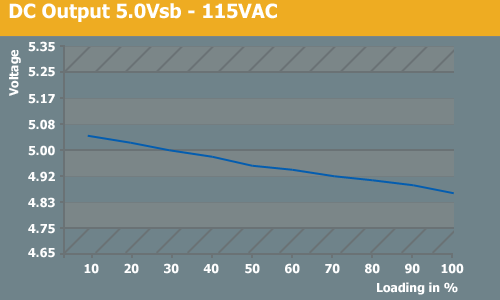
115VAC 12V Rail Tests
The 12v rails all performed very well during the test and none ran out of spec. We tested the power supply with the little OCP knob off as we mentioned before (the default configuration). That means that we should have been working with only one 12v rail. As we connected the cables to our machines we discovered that there are in fact four 12v rails at all times. It doesn't matter if you switch this knob off or on, the result will be the same. This could have just switched off OCP on each rail, meaning that they would be separated in some other way. The rails are separated to supply the following:
- 12V1 is supplying the Motherboard (yellow/blue cable)
- 12V2 is connected to the 4pin connector for the CPU (yellow/black cable)
- 12V3 is supplying the second 4pin connector which results in the 8pin connector (yellow cable)
- 12V4 is responsible for all the rest including the PCI-Express cards and components (yellow/green cable)
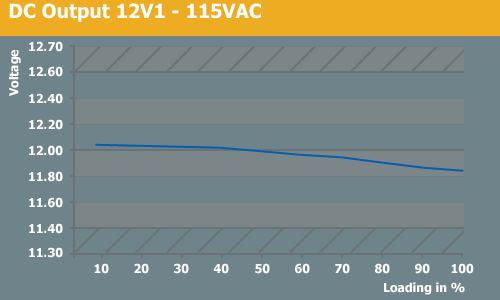
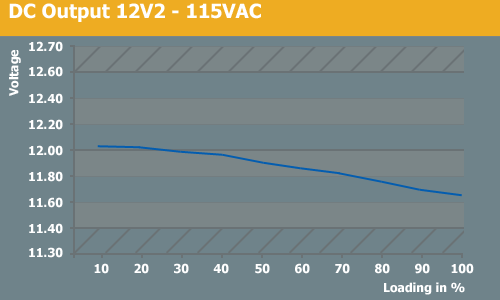
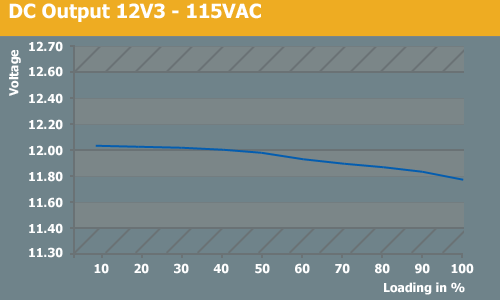
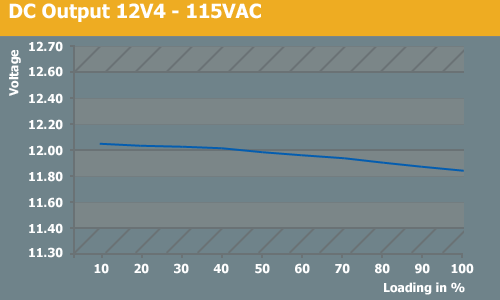
115VAC Efficiency, Power loss and PFC
Efficiency is one of the most important factors nowadays in power supplies. PSU marketing and advertising are completely dependent on efficiency in most cases. At 115VAC we have measured a little more than 80% efficiency from 25% to 60% load. That is surely an impressive number with 115VAC. It is nice to see that Silverstone is able to maintain this high efficiency through the full spectrum of loads and not only for a few specific loads like some other power supplies. After it reached its zenith it steadily declines in efficiency, but not too rapidly.
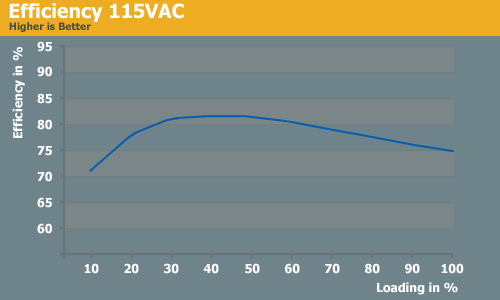
Due to a high efficiency the power loss was in quite good shape as well. The thinner this graph is the less power loss we have measured. The loss of power is always higher towards the highest load which results in the figure below.

Even when you turn your PC off it is, unfortunately, still using energy if you don't hit the hard power switch on the backside. This is the standby function which lets the PC start with soft power features like wake on LAN. Since the PC is on standby it is always using energy from the grid. We have included this test to check power supply's standby function and their energy usage while the PC is off. With 115VAC the OP650 is using 1.19 watts of energy while doing "nothing" which is not a very high result. If you leave the PC off for a long period of time, you should still always hit the switch or unplug the cable.
To test the standby-efficiency we are using the loads of 0.1, 0.5 and 3.0 Ampere on the 5VSB rail while the power supply is not running. The result is the efficiency of each load shown below. The results are quite average but not low. A standby-efficiency of 72% with 3 Ampere of load is very good.
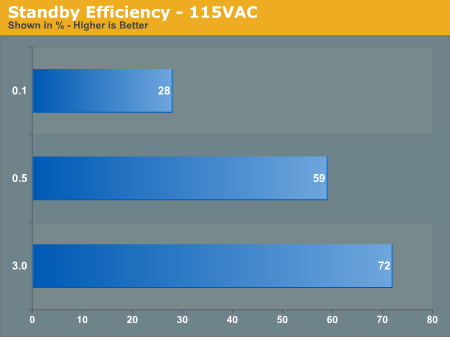
Power factor correction works fine and delivers the usual high results. It always performs better at 115VAC as opposed to 230VAC.
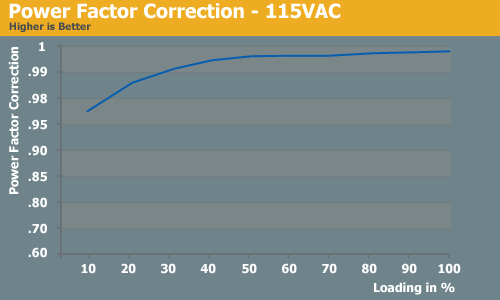
230VAC 3.3V, 5V, and 5Vsb Tests
This is the same test we ran earlier only using 230VAC. Since the power supply just came out of its box fresh and unused when we ran these tests, the results might look a little better than the ones with 115VAC. Still, the lower voltages like 3.3 and 5V dropped significantly and went under the spec limit at higher loads. This would not be acceptable in a real system, as it would not work properly after the voltage dropped that much. Of course, our test setup does represent a worst case scenario, as most users will not run with temperatures as high as we do.
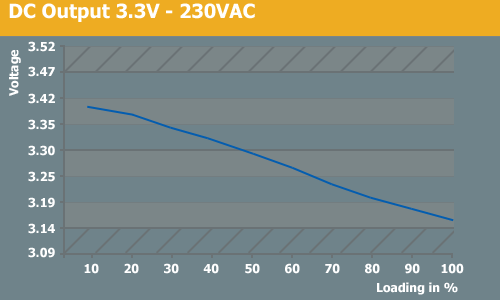
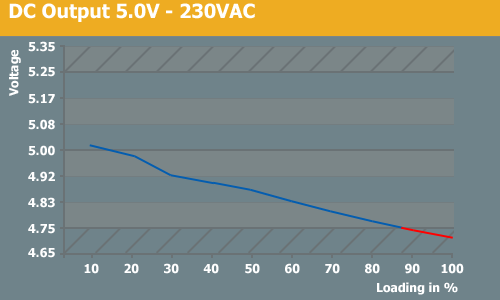
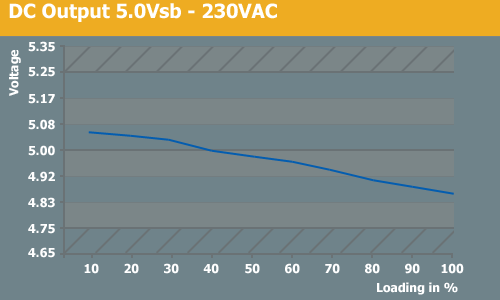
230VAC 12V Rails
We talked about the distribution of the different 12v rails to the system on the 115VAC 12V test page. It is very important that the 12v rails are holding steady and within spec because most of the system is highly dependent on them. The voltage drop was not that much and completely acceptable on the 12v rails. A constant drop is always seen with increasing temperature.
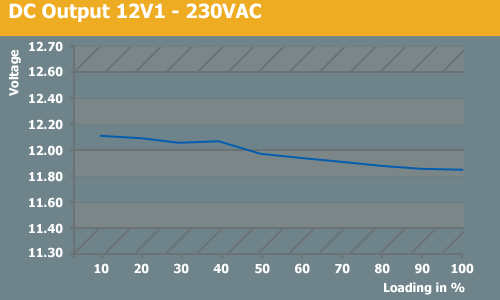
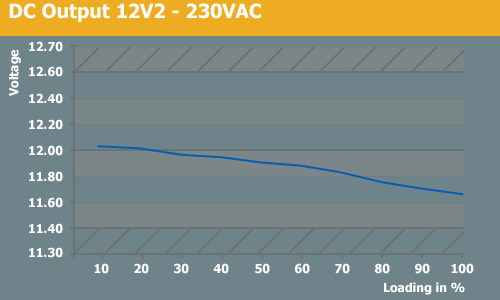
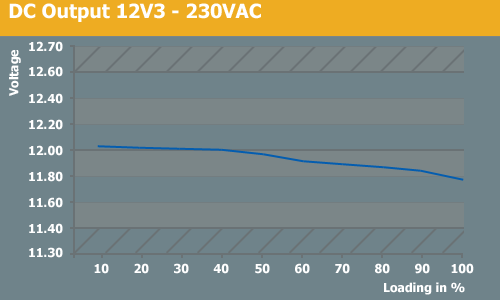
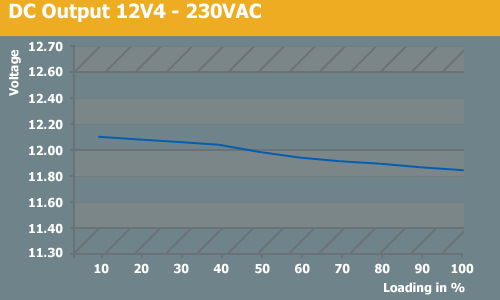
230VAC Efficiency, Power loss, PFC
With higher input voltage is the efficiency increases as well. We have measured a very nice 83.33% efficiency at just 40% load. In total we had more than 80% efficiency from 20 to 90% load which is a very good result from the OP650. This power supply will always provide good results in PCs with more than 130 watts constant load when connected to 230VAC power.

The loss of power is not that large as a result of the high efficiency at 230VAC. The upper line marks the power input and the lower line marks the output. The space in between is the power which has been lost during the work.
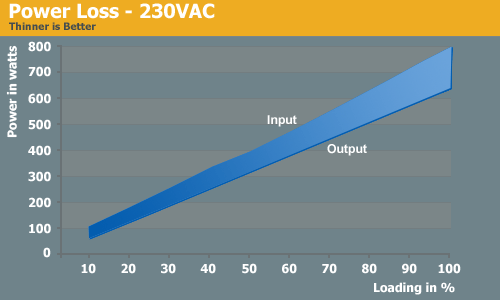
Again, we tested the standby power draw of the Silverstone supply, this time with 230VAC. With 230VAC the OP650 is using 1.7 watts of energy while doing "nothing" which is a slightly higher result than what we saw when connected to a 115VAC power grid. If you leave the PC off for a longer time you should always hit the switch or even unplug the cable. This not only saves you money, but could potentially help save wear and tear due to power surges, especially in areas with unreliable power.
The standby-efficiency was again tested with the loads of 0.1, 0.5 and 3.0 Ampere on the 5VSB rail while the power supply is not running. We see that the efficiency is slightly lower with 230VAC than with 115VAC. At 3 Ampere loading it is the same like with 115VAC.
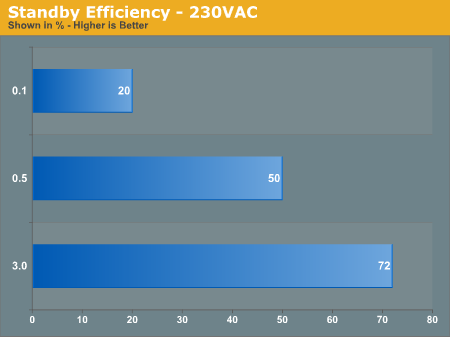
The power factor correction with 230VAC was at an average level and working fine.
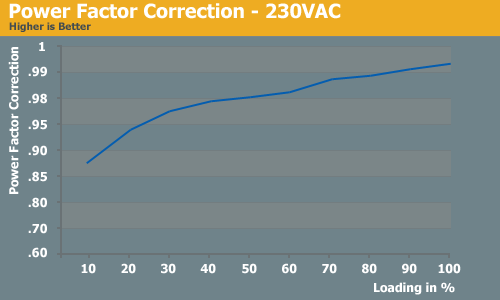
Temperatures
Temperatures inside of the power supply are a very important design aspect and difficult to handle by the manufacturers. The heatsinks need to have a decent size while still letting air through to cool down other components on the PCB. The primary heatsink does not get as hot as the secondary does. At the beginning of each test we connect two temperature diodes to the heatsinks to measure the increasing heat. We are then able to compare these results with the speed of the fan and the exhausted air. With hot heatsinks and cold exhausted air the power supply clearly has a problem with bad airflow or bad heatsink-design.
During the test the primary heatsink reached a temperature of just 60°C which was exactly the same temperature the exhausted air had. The secondary heatsink reached just about 90°C which is quite hot. With just 38 dB(A) and a fan speed of 2300 rpm this power supply had a fan as powerful as any other and should have cooled things a little better. This makes us question whether the heatsink design could have been better, or if a larger heatsink would have made more sense. Compared to each other the primary heatsink has around 30-40% bigger volume than the secondary. Soon we will test the 850W version of this series which will give us more insight into whether or not this is a general issue with Silverstone's heatsink design.
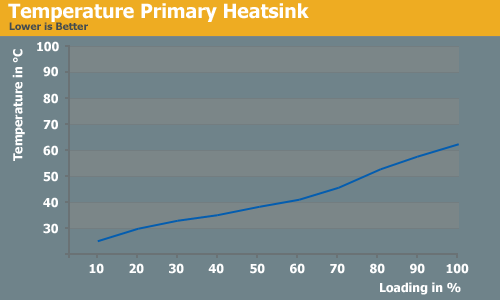
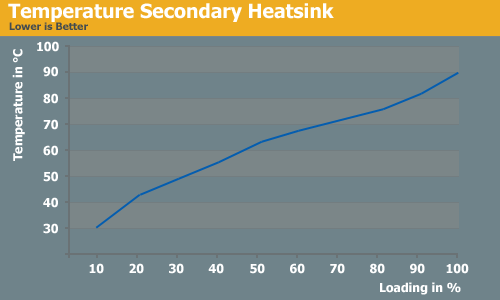

Acoustics
The fan control does a good job on this model. The fan is rotating with a minimum speed with up to a 50% load on the power supply. This means you can put a little more than 300 watts load on it before you will experience an increase in PSU noise. The tests re conducted in a special room which isolates the power supply from the noisy Chroma. In this way we can get accurate measurements of the power supply only. The microphone is measuring in two different loacations. The first one is around 30cm far from the backside of the power supply and the second measurement is being taken from 1m distance. The ambient-noise is minimized through the 5-layer thick wall containing different isolating materials.
Running in an average system, the measured 26 dB(A) would not be the loudest thing to worry about and wouldn't significantly contribute to the overall SPL of the system. If running with more than 60% the fan will constantly spin faster and reach up to 38 dB(A) noise which is still an acceptable result for most PCs but not really calm anymore.
From a subjective point of view the noise is not too loud either. The power supply didn't produce any noise other than from the fan which can be quite bothersome from time to time. There is no ticking noise from the fan either.
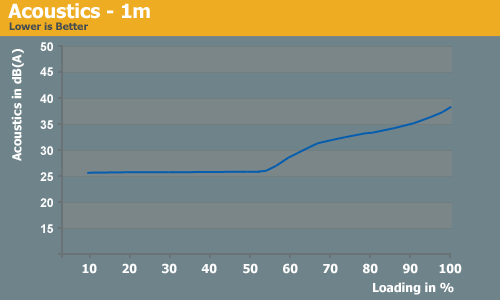
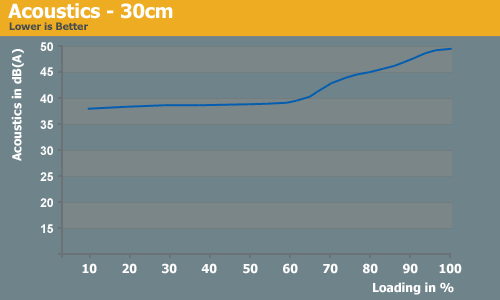
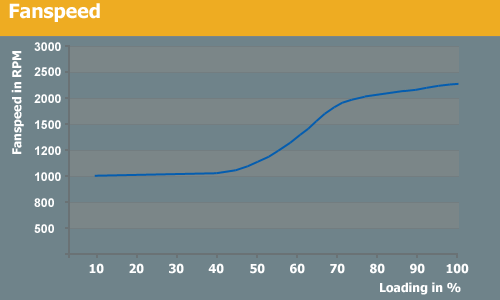
Final Words
Compared to former power supplies from Silverstone we can say that the company made an aggressive but logical step forward. With 650 watt it is one of the higher performing power supplies and therefore not suiting every users needs. With an efficiency of over 80% at lower loads (with 230VAC) it could run a decent medium class PC without wasting too much energy.
Due to the increasing temperature of our tests, we saw the voltages drop, especially on the lower voltage rails. The chosen high-end components have been a good fit for the most part but heat is still an issue. The new crew of engineers has come up with a good PCB design as well. From the high overall quality, one can literally see the robots installing these components.
The heatsinks have a very clever shape to let much air through to the PCB to cool down most of the components where they stand. They have a decent thickness as well which allows for a lot of heat conduction. The temperature of the heatsinks was average but we have seen colder ones. As for fan speed, the produced noise level was not the best result we could have hoped for, but it seems to be necessary to cool down the power supply to keep it working properly. We would love to see Silverstone take a second look at the fan speed and adjustments. The sound issue shouldn't be a real problem for most users who chose this PSU, as they will not be able to load the PSU anywhere near 80%. Not many people will ever hear this power supply with full load.
Protection features work fine in this model. The power supply correctly shuts down with any potential threat to its life such as over current or over power. Our short circuit test on each line during different loading stages had a positive outcome too with no damage to our unit.
In case of efficiency the OP650 has surprised us in a good way. At 230VAC it reached 80% efficiency with the impressively low load of 20%. At a medium load we saw an impressive 83% efficiency which held on until our highest load tests. At the lowest input of 115VAC we could only reach an efficiency of 81% which is still a very good result. In case of standby efficiency we measured just about 1.19W at 115VAC and 1.7W at 230VAC which is not a very high energy loss: exactly what we would like to see.
The price of the OP650 is just about $160 in the United States and around 139€ in Europe which is a reasonable price for a 650W power supply. It is a good price for the quality and performance this power supply brings to the table.
The build quality of the Olympia series is unmatched from other series of Silverstone PSUs which makes it the highest performer the company offers. We are looking forward where this leads in the future and what power supplies Silverstone will put out next.







